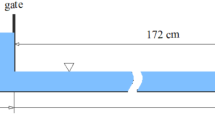Abstract
An experiment that investigates the interactions between dam-break flow and a floating box is reported in this paper. The interaction processes are described in detail, and the effects of reservoir depth, clearance between the structure and vertical wall, and structure motion on the observed interactions are discussed. Results indicate that interactions are mild if the reservoir depth is relatively small and most of the water flows through under the structure. However, as the reservoir depth increases, the interactions intensify, and overtopping and wave splashing occur. The incident wave is divided into two parts by the structure: 1) a jet generated by wave impact and 2) the water flowing through under the structure. The water flowing through under the structure is the main factor influencing the motion of the structure. The phenomenon of secondary slamming is observed in all of the test cases, and the relative motion of the structure and free surface explains the occurrence of secondary slamming.
Similar content being viewed by others
References
Buchner, B., 2002. Green water on ship-type offshore structures. PhD thesis. Delft University of Technology.
Bukreev, V. I., and Zykov, V. V., 2008. Bore impact on a vertical plate. Journal of Applied Mechanics and Technical Physics, 49 (6): 926–933.
Gerritsen, H., 2005. What happened in 1953? The Big Flood in the Netherlands in retrospect. Philosophical Transactions of the Royal Society A, 363 (1831): 1271–1291.
Greco, M., Colicchio, G., and Faltinsen, O. M., 2007. Shipping of water on a two-dimensional structure. Part 2. Journal of Fluid Mechanics, 581: 371–399.
Greco, M., Faltinsen, O. M., and Landrini, M., 2005. Shipping of water on a two-dimensional structure. Journal of Fluid Mechanics, 525: 309–332.
Hernández-Fontes, J. V., Esperança, P. de T. T., Graniel, J. F. B., Sphaier, S. H., and Silva, R., 2019. Green water on a fixed structure due to incident bores: Guidelines and database for model validations regarding flow evolution. Water, 11 (12): 2584.
Hernández-Fontes, J. V., Vitola, M. A., Silva, M. C., Esperança, P. de T. T., and Sphaier, S. H., 2018. On the generation of isolated green water events using wet dam-break. Journal of Offshore Mechanics and Arctic Engineering — Transactions of the ASME, 140 (5): 51101.
Hu, Z., Xue, H., Tang, W., and Zhang, X., 2015. A combined wave-dam-breaking model for rogue wave overtopping. Ocean Engineering, 104: 77–88.
Jánosi, I. M., Jan, D., Szabó, K. G., and Tél, T., 2004. Turbulent drag reduction in dam-break flows. Experiments in Fluids, 37 (2): 219–229.
Jung, K. H., Chang, K.-A., and Jo, H. J., 2006. Viscous effect on the roll motion of a rectangular structure. Journal of Engineering Mechanics—ASCE, 132 (2): 190–200.
Kao, H. M., and Chang, T. J., 2012. Numerical modeling of dam-break-induced flood and inundation using smoothed particle hydrodynamics. Journal of Hydrology, 448: 232–244.
Kristiansen, T., and Faltinsen, O. M., 2010. A two-dimensional numerical and experimental study of resonant coupled ship and piston-mode motion. Applied Ocean Research, 32 (2): 158176.
Lauber, G., and Hager, W. H., 1998. Experiments to dambreak wave: Horizontal channel. Journal of Hydraulic Research, 36 (3): 291–307.
Li, J., You, Y., Chen, K., and Zhang, X., 2019. Numerical computations of resonant sloshing using the modified isoAdvector method and the buoyancy-modified turbulence closure model. Applied Ocean Research, 93: 101829.
Lobovský, L., Botia-Vera, E., Castellana, F., Mas-Soler, J., and Souto-Iglesias, A., 2014. Experimental investigation of dynamic pressure loads during dam break. Journal of Fluids and Structures, 48: 407–434.
Lu, S., Liu, H., and Deng, X., 2018. An experimental study of the run-up process of breaking bores generated by dam-break under dry- and wet-bed conditions. Journal of Earthquake and Tsunami, 12 (2): 1840005.
Mokhtar, Z. A., Mohammed, T. A., Yusuf, B., and Lau, T. L., 2019. Experimental investigation of tsunami bore impact pressure on a perforated seawall. Applied Ocean Research, 84: 291–301.
Ning, D., Zhao, X., Göteman, M., and Kang, H., 2016. Hydrodynamic performance of a pile-restrained WEC-type floating breakwater: An experimental study. Renewable Energy, 95: 531–541.
O’Donoghue, T., Pokrajac, D., and Hondebrink, L. J., 2010. Laboratory and numerical study of dambreak-generated swash on impermeable slopes. Coastal Engineering, 57 (5): 513–530.
Ozmen-Cagatay, H., and Kocaman, S., 2011. Dam-break fow in the presence of obstacle: Experiment and CFD simulation. Engineering Applications of Computational Fluid Mechanics, 5 (4): 541–552.
Ryu, Y., Chang, K.-A., and Mercier, R., 2007. Application of dam-break flow to green water prediction. Applied Ocean Research, 29 (3): 128–136.
Shigematsu, T., Liu, P. L.-F., and Oda, K., 2004. Numerical modeling of the initial stages of dam-break waves. Journal of Hydraulic Research, 42 (2): 183–195.
Stansby, P. K., Chegini, A., and Barnes, T. C. D., 1998. The initial stages of dam-break flow. Journal of Fluid Mechanics, 374 (1): 407–424.
Tan, L., Lu, L., Tang, G., Cheng, L., and Chen, X., 2019. A viscous damping model for piston mode resonance. Journal of Fluid Mechanics, 871: 510–533.
Yilmaz, O., Korobkin, A. A., and Iafrati, A., 2013. The initial stage of dam-break flow of two immiscible fluids. Linear analysis of global flow. Applied Ocean Research, 42: 60–69.
Zhang, Y., Li, M., Zhao, X., and Chen, L., 2020. The effect of the coastal reflection on the performance of a floating break-water-WEC system. Applied Ocean Research, 100: 102117.
Acknowledgements
The study was supported by the National Key Research and Development Program of China (No. 2016YFC0303 401), the National Natural Science Foundation of China (No. 51779236), and the National Natural Science Foundation of China-Shandong Joint Fund (No. U1706226).
Author information
Authors and Affiliations
Corresponding author
Rights and permissions
About this article
Cite this article
Wang, D., Dong, S. Experimental Investigation on the Interactions Between Dam-Break Flow and a Floating Box. J. Ocean Univ. China 21, 633–646 (2022). https://doi.org/10.1007/s11802-022-4842-4
Received:
Revised:
Accepted:
Published:
Issue Date:
DOI: https://doi.org/10.1007/s11802-022-4842-4




